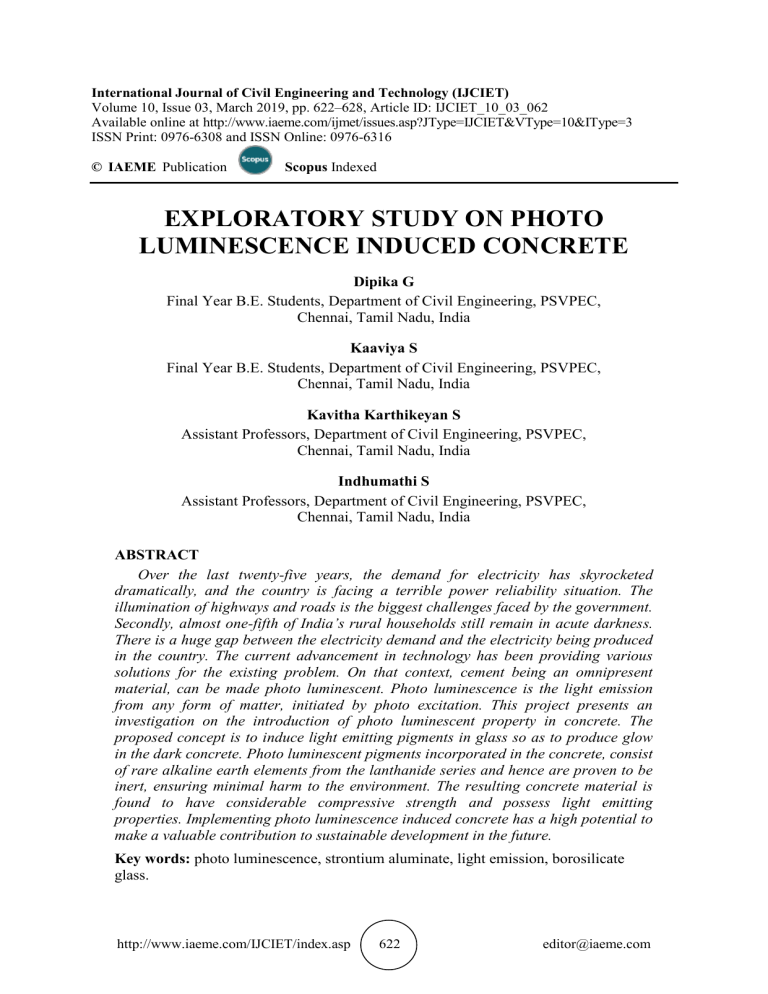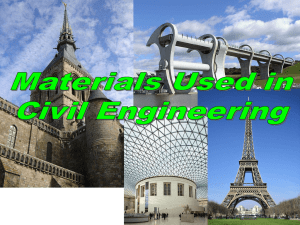EXPLORATORY STUDY ON PHOTO LUMINESCENCE INDUCED CONCRETE
advertisement

International Journal of Civil Engineering and Technology (IJCIET) Volume 10, Issue 03, March 2019, pp. 622–628, Article ID: IJCIET_10_03_062 Available online at http://www.iaeme.com/ijmet/issues.asp?JType=IJCIET&VType=10&IType=3 ISSN Print: 0976-6308 and ISSN Online: 0976-6316 © IAEME Publication Scopus Indexed EXPLORATORY STUDY ON PHOTO LUMINESCENCE INDUCED CONCRETE Dipika G Final Year B.E. Students, Department of Civil Engineering, PSVPEC, Chennai, Tamil Nadu, India Kaaviya S Final Year B.E. Students, Department of Civil Engineering, PSVPEC, Chennai, Tamil Nadu, India Kavitha Karthikeyan S Assistant Professors, Department of Civil Engineering, PSVPEC, Chennai, Tamil Nadu, India Indhumathi S Assistant Professors, Department of Civil Engineering, PSVPEC, Chennai, Tamil Nadu, India ABSTRACT Over the last twenty-five years, the demand for electricity has skyrocketed dramatically, and the country is facing a terrible power reliability situation. The illumination of highways and roads is the biggest challenges faced by the government. Secondly, almost one-fifth of India’s rural households still remain in acute darkness. There is a huge gap between the electricity demand and the electricity being produced in the country. The current advancement in technology has been providing various solutions for the existing problem. On that context, cement being an omnipresent material, can be made photo luminescent. Photo luminescence is the light emission from any form of matter, initiated by photo excitation. This project presents an investigation on the introduction of photo luminescent property in concrete. The proposed concept is to induce light emitting pigments in glass so as to produce glow in the dark concrete. Photo luminescent pigments incorporated in the concrete, consist of rare alkaline earth elements from the lanthanide series and hence are proven to be inert, ensuring minimal harm to the environment. The resulting concrete material is found to have considerable compressive strength and possess light emitting properties. Implementing photo luminescence induced concrete has a high potential to make a valuable contribution to sustainable development in the future. Key words: photo luminescence, strontium aluminate, light emission, borosilicate glass. http://www.iaeme.com/IJCIET/index.asp 622 editor@iaeme.com Exploratory Study on Photo Luminescence Induced Concrete Cite this Article: Dipika G, Kaaviya S, Kavitha Karthikeyan S, Indhumathi S, Exploratory Study on Photo Luminescence Induced Concrete, International Journal of Civil Engineering and Technology 10(3), 2019, pp. 622–628. http://www.iaeme.com/IJCIET/issues.asp?JType=IJCIET&VType=10&IType=3 1. INTRODUCTION Cement played a vital role in the construction field, ever since the ancient time. Birth of many new construction materials after the industrial revolution, dominated the world with its advancements and efficiency. The cement created by Joseph Aspdin, still serves as a key element in the creation of various types of special cements to meet the criteria required. Energy resources are gradually decreasing as the demand keeps increasing. The government faces a major problem in illuminating streets and highways. Frequent blackouts cause difficulty among travelers to recognize the path and pose a great threat to their sense of safety and security. Being an abundantly available material in the world, cement can be induced with certain types of photo luminescent pigments, to absorb light and emit it in the absence of the light source. Photo luminescence is generally said to be defined as the emission of light, caused when light is absorbed in the form of photons and causes the electrons to jump from their energy levels. Various sources of light energy can be used to charge up the photo luminescent material. Sunlight, a naturally available light energy source, can be used to obtain brighter glow in the photo luminescent material. This solution is similar to other conventional energy sources as it primarily depends on a natural energy source. Though the initial cost is high, it will prove to be cost effective in terms of operational and maintenance cost. This journal presents a framework which suggests the method of introducing photo luminescence induced concrete by the introduction of light emitting glow in the dark pigments. It ensures safety in streets that lacks proper lights, thereby creating a well-lighted environment and might decrease the rate of accidents due to improper lighting facilities. For the current world that deals with a lot of pollution and environmental degradation, this solution will turn out to be eco-friendly and only has a less impact on the human health & environment, as the key components are non-radioactive rare earth elements. 2. REVIEW OF LITERATURES T. Subramani et al published a journal on Transparent Concrete created by the use of optical fibres. Transparent concrete is a concrete based building material with light-transmitting properties due to embedded light optical elements usually optical fibers. The mix design of M40 concrete was adopted wherein optical fibers were reinforced in to the concrete by 5% and 10% based on surface area. Different tests like Compressive strength test, split tensile strength, Flexural strength test were carried on the specimen. The results evidently show that as the percentage of optical fiber increases the strength also increases. Inference: Use of coarse aggregate hinders the light transmitting ability of the transparent concrete. News article in CNN Style (July, 2016) Mexican scientist José Carlos Rubio Avalos has invented a glow-in-the-dark cement that acts as an energy-efficient material soaks up sunlight during the daytime and begins to emit light as the sun sets. He added photoactive materials to the cement to absorb and emit light, but the greatest challenge was to make the cement, an opaque material, soak up UV rays. To do this, he had to alter its microstructure. Inference: Glow obtained from the crystallization process of cement yields shorter wavelengths in the visible spectra. http://www.iaeme.com/IJCIET/index.asp 623 editor@iaeme.com Dipika G, Kaaviya S, Kavitha Karthikeyan S, Indhumathi S Journal of the American Ceramic Society, January 2005, Tooru Katsumata et al published a journal explaining the characteristics of strontium aluminate crystals. Sr3Al2O6, SrAl2O4, SrAl4O7, and SrAl12O19 that have been doped with Eu2+ and Dy3+ ions were grown by a floating‐zone technique to be used as long‐duration phosphors. The peak wavelengths of the phosphorescence were observed to be 520 nm for SrAl2O4, 480 nm for SrAl4O7, and 400 nm for SrAl12O19. The decay times of the phosphorescence were analyzed by a curve fitting techniques. The phosphorescence is characterized by decay times that have been analyzed by a curve‐fitting technique. Inference: Strontium Aluminate doped with Europium and Dysprosium activators is proven to generate 10 times brighter light within a lesser amount of exposure period. 3. STUDY OF MATERIALS The materials used in this project are cement, fine aggregate, borosilicate glass induced with photo luminescent pigment, glass fiber and water. 3.1. Ordinary Portland cement (OPC) The cement used for this project was OPC 53 grade cement. All the tests on cement were conducted according to IS 4031. The following tests were done: Fineness test of cement - IS 4031 part 1 Consistency of cement - IS 4031 part 4 Initial and final setting time - IS 4031 part 5 Compressive strength of cement - IS 4031 part 6 3.2. Fine aggregate Various issues such as limited sand resources, illegal mining of river sand and environmental impacts of sand mining that affects the ecosystem, led to the discovery of an alternative called M-Sand. Since it causes less damage to the surroundings and yields higher strength in concrete when compared to river sand, M-Sand conforming to the standards of IS 383-1970 was opted as the fine aggregate. 3.3. Photo luminescent pigment A pigment that has the ability to produce light in a dark environment is said to be photo luminescent. Strontium Aluminate doped with rare alkaline earth elements from the lanthanide series, primarily Europium and Dysprosium, is proven to absorb radiant light energy and slowly release it as glow in the absence of the light source. Hence Strontium Aluminate doped with Europium and Dysprosium activators was adopted to achieve brighter afterglow in the concrete. 3.4. Borosilicate Glass Silica and Boron trioxide, used as the main glass forming constituents, yield borosilicate glass. They have a very low co-efficient of thermal expansion, making them resistant to thermal shock. These glasses are induced with the photo luminescent pigment and introduced over the top surface of the concrete. http://www.iaeme.com/IJCIET/index.asp 624 editor@iaeme.com Exploratory Study on Photo Luminescence Induced Concrete Figure 1 Pigment induced borosilicate glass 3.4. Glass Fiber Glass fibers are generally numerous amount of fibers used in concrete to control the effects of shrinkage on concrete. They also provide resistance against abrasion and can be used in the many different forms. Alkali resistant glass fibers are used to withstand chemical reactions in OPC and to provide strength in concrete. To obtain a nominal strength in concrete, the amount of glass fiber taken is generally in the range of 0 – 1% by weight of cement. Increase in the amount leads to decrease in compression strength of the concrete. Chopped glass fibers of size 6 mm is used in our mix and Chopped strand mat of glass fiber is used to cover the sharp surface of the glass induced with pigment over the surface of the concrete. 4. CALCULATION OF MATERIALS Ratio of cement and fine aggregate = 1:3 Exposure condition = Moderate Water-cement ratio = 0.5 4.1. Final quantity of materials For casting 12 cubes (100x100x100mm), the following quantity of materials were calculated. Cement = 7.5kg Fine aggregate = 22.5kg Pigment induced glass = 0.75kg Glass fiber = 0.075kg 5. CASTING OF MORTAR CUBES Strength of concrete can be determined with the help of compressive strength test. The materials are weighed carefully so as to yield better results. This concrete does not deal with coarse aggregates and hence moulds of size 100 x 100 x 100 mm are used. The moulds are cleaned properly and coating of oil is provided along the inner portion of the moulds. Hand compacting is done with the help of a tamping rod. Concrete is placed in the mould for a depth of 85 mm and the glass particles induced with photo luminescent pigment is introduced over the topmost layer of the concrete in the mould for a depth of 15 mm. The cube is then removed from the mould after a duration of 24 hours. Due to the sharp edges of the glass over the topmost surface of the concrete, chopped stranded glass mat is provided over it. The cubes are marked and are submerged into curing tanks and are only taken out for testing at various intervals. http://www.iaeme.com/IJCIET/index.asp 625 editor@iaeme.com Dipika G, Kaaviya S, Kavitha Karthikeyan S, Indhumathi S Figure 2 Casting of mortar cubes 6. OBSERVATION OF LIGHT EMISSIVE NATURE It is a known fact that atoms emit light when the electrons jump in between energy levels. Photo luminescence revolves around these phenomena that attributes to absorption of the light in day time and emits in the night time. After careful analysis between ZnS and SrAl2O4, the latter yielded better results in terms of brightness in glow and duration of emission of light. Hence, the pigment we adopted is grade 0 strontium aluminate (SrAl2O4) which is a long afterglow pigment. SrAl2O4 doped with Europium and Dysprosium activators are used to enhance the duration of glow and other brightness characteristics. Even though various sources of light can be used for charging the pigment, it strongly responds to sunlight. Therefore, as discussed earlier, sunlight is used to excite the photo luminescent material and it will prove to be more convenient to use in real time cases. The photo luminescence induced concrete is initially charged in the presence of sunlight and a comparative study to determine the duration of afterglow after a certain period of charging is estimated. TIME TAKEN FOR LIGHT ABSORPTION DURATION OF AFTERGLOW 30 seconds 10 minutes 1 hour 10 minutes 25 minutes 70 minutes Evaluation of the afterglow yielded that the glow is affected by moisture content present in the cube. It serves as a hindrance to the duration of afterglow. The evaluation also yielded that the glow is brighter for a duration of 2 minutes in the beginning of afterglow, and the brightness decreases in a fixed percentage. Due to factors such as percentage of pigment induced, humidity in the environment etc., the afterglow did not exceed for a duration more than 2 hours, even after charging for more than an hour. Figure 3 Blocks exposed to sunlight produce glow in a dark environment http://www.iaeme.com/IJCIET/index.asp 626 editor@iaeme.com Exploratory Study on Photo Luminescence Induced Concrete 7. TEST RESULTS Cubes are tested at 7th day, 14th day and 28th day. The average compressive strength of the cubes is as follows: Average compressive strength obtained at 7th day testing = 19.1666 N/mm2 Average compressive strength obtained at 14th day testing = 25.033 N/mm2 Average compressive strength obtained at 28th day testing = 30.466 N/mm2 A graphical representation between the strength obtained in 7th, 14th and 28th day is as follows: Figure 4 Graphical representation of compressive strengths 8. CONCLUSIONS A novel self sustainable material was developed by the introduction of photo luminescent properties in concrete. Concrete being an opaque material, light emitting properties were to be integrated in glass so as to create a glow in the dark surface. In this investigation, the photo luminescent pigments used were about 10% of weight of cement. The findings we have presented suggest that the percentage of pigment can be increased to up to 50% in order to amplify the glow produced. The project has helped us to learn about the effect of photo luminescent properties on the strength of the concrete. There were several constraints we had faced during the course of the project. Firstly, the photo luminescent pigment was not locally available, and we had to outsource the material from abroad. The instrument required to measure the light emissivity of the concrete was unavailable in Tamil Nadu, and we had to change our initial approach from creating a photo luminescent concrete block to the introduction of photo luminescent only to the top surface. The cost of the pigment was another major issue, and we had to limit the percentage of pigment to 10%. The implementation of photo luminescence induced concrete at a large scale would prove to be an ideal alternative for the illumination of roads and to light up the rural households of the country. It would be fruitful to pursue further research on this concept in order to help the construction industry to provide effective solutions to this existing problem of lack of energy resources. REFERENCES [1] International Journal of Emerging Trends & Technology in Computer Science (IJETTCS), Volume 7, Issue 2, March - April 2018 ,Transparent Concrete Concept By Replacing Fine Aggregate Of Waste Glass By Using Admixture In Optical Fibre http://www.iaeme.com/IJCIET/index.asp 627 editor@iaeme.com Dipika G, Kaaviya S, Kavitha Karthikeyan S, Indhumathi S [2] “Glow-in-the dark cement could revolutionize how we light cities” - José Carlos Rubio Avalos (2016) [3] “Characteristics of Strontium Aluminate Crystals Used for Long‐Duration Phosphors” Tooru Katsumata (2005) [4] Photoluminescence: Advances in Research and Applications – Ellis Marsden [5] Cathodoluminescence and Photoluminescence: Theories and Practical Applications – Lyuji Ozawa [6] www.google.com [7] en.wikipedia.org [8] www.sciencedirect.com [9] www.researchgate.net [10] theconstructor.org http://www.iaeme.com/IJCIET/index.asp 628 editor@iaeme.com


